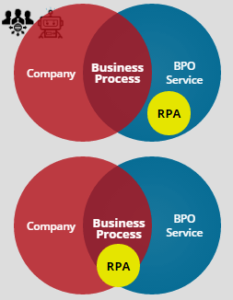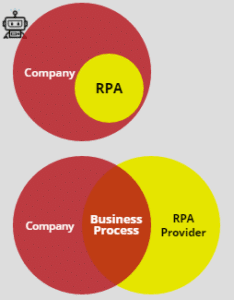Welcome to your business process outsourcing (BPO) and robotic process automation (RPA) knowledge hub at Burnie Group
Defining BPO and RPA
Business Process Outsourcing
Business process outsourcing (BPO) is the contracting of selected business processes and functions of an organization to a third-party provider. BPO provider services can include such functions as human resources (HR), payroll, accounting, call centre, and more.
Robotic Process Automation
Robotic process automation (RPA) is the application of technology for automating complex business processes. Software robots act as virtual workers. They capture and interpret applications to process a transaction, manipulate data, trigger responses, and communicate with other digital systems – tasks that are usually performed by a person or team.
Interested in finding out how we can help you find an alternative BPO or drive more efficiency from your existing BPO?
CONNECT WITH USPotential Benefits of BPO and RPA
Pure BPO
Pure BPO – Company outsources a part of its business processes to a BPO provider.
Potential Cost Saving – 15% to 40% within 5 years. The cost savings increase as the outsourced process matures and goes through continuous improvements.
Other Benefits – Business risk reduction, improved customer experience, new revenue stream creation potential for the organization, increased transparency and access to world standards are some of the key intangible benefits of BPO.
Robotic Process Automation
Robotic Process Automation:
- Company has own Center of RPA excellence and applies RPA to own processes.
- Company partners with an RPA provider which offers RPA services for a part of the business services.
Cost Savings Potential – 10% to 65% according to The National Association of Software and Services Companies (NASSCOM), where offshore delivery yields 10% to 30% and onshore process operations yields 35-65% with an investment recovery of 6-9 months.
Other Benefits – Customer experience, flexibility and scalability, accuracy and quality, fast deployment, new revenue stream creation potential
RPA within BPO

RPA within BPO:
- BPO provider uses RPA to offer even lower rates by applying RPA to own processes.
- Company uses both BPO and RPA levers applied to the same processes.
Cost Savings Potential – 50% to 95% according to The National Association of Software and Services Companies (NASSCOM). RPA in BPO assumes an end-to-end driven approach, integration of predictive and prescriptive analytics to guide decision support, and an output and outcome-based model.
Other Benefits – Combined benefits from RPA and BPO with additional mitigation of BPO cons due to implementation of Robotic Process Automation.
Scope of BPO and RPA
Features of the Processes Best Suitable for…
Repetitive
Rules-based
Streamlined
Very unique
without IT
support
BPA
Non-frequent
Not rules-based
RPA
Both BPO and RPA aim to achieve the goal of streamlining processes, achieving efficiency and increased productivity, and yielding cost benefits.
BPO and RPA implementations allow organizations to perform back office, internal, and call centre tasks efficiently quickly. This provides enterprises the benefits of overhead cost reduction, improved productivity, better quality, and more.
Both RPA and BPO are most applicable for business processes that are
– Frequent (consistent daily/weekly volumes)
– Repetitive (e.g. data entry tasks)
– Rules-based (the process is defined by precise decision rules)
– Streamlined (stable, without redundant steps).
BPO and RPA – Pros and Cons
Business Process Outsourcing
Pros
- ✔ Cost reduction – Infrastructure, recruitment, training, and operational costs are reduced when processes are outsourced to specialized BPO providers.
- ✔ Business risk reduction – Process-related risks and responsibilities of organizations are shared with BPO service providers.
- ✔ Improved customer experience – Customer experience improves due to accurate and timely process delivery by specialized BPO providers.
- ✔ New revenue stream creation potential – Outsourcing can allow employees to engage in more diverse and value-adding core business activities.
Cons
- ✔ Data security and privacy – There may exist risks of exposing confidential HR, recruitment, payroll, accounting data when working with a third-party provider.
- ✔ Loss of process control – Classifications of responsibilities and deliverables standards may differ between and organization and a BPO service, which can lead to loss of control over the performed business processes.
Robotic Process Automation
Pros
- ✔ Cost reduction – Operational, hiring, attrition, and other costs are reduced when processes are handled by robotic workforce.
- ✔ Fast results - RPA implementations efficiently transition from development to production in short time frames, driving sales and eliminating delays.
- ✔ Flexibility and scalability – Robotic workforce handles increases in scale without additional ramp-up time and resource constraints, supporting both organizational growth and seasonality.
- ✔ Accuracy and quality – Robotic workforce lowers operational risk as its performance is consistent and does not deviate from defined business-rules, committing no data entry or other errors.
- ✔ Improved customer experience – Customer experience improves due to accurate and timely process delivery by the robotic workforce.
- ✔ New revenue stream creation potential – Outsourcing can allow employees to engage in more diverse and value-adding core business activities.
Cons
- ✔ Necessity for a stable process – RPA works best with a repetitive, rules/templates-based process that is stable and has a proven business need. Processes that have high proportions of exceptions, complex decision-making, and logic changes are best for human agents.
What happens when BPO and RPA are combined
Business Process Outsourcing and Robotic Process Automation are both used to achieve the same goals – improving quality, efficiency, and reducing costs. As the global business environment is going through fundamental shifts in technology, economy, demographics, and consumer preferences, leveraging the benefits of BPO and RPA together becomes vital for success.
RPA already yields the benefits traditionally attributed to BPO, such as cost savings, improved customer experience, and creation of new revenue streams for organizations. However, RPA also brings forth new strengths – fast results, ease of scalability and flexibility, accuracy and quality. Additionally, use of RPA in BPO mitigates potential process control and data privacy and security risks. It is reasonable to assume that a hybrid model that integrates RPA and BPO has the potential to transform entire industries.
BPO and RPA in different industries
Banking
- Core functions:
- Setting new banking clients/accounts (e.g. cards, loans)
- Everyday management of existing accounts
- Back-office:
- Credit assessment
- Fraud prevention
RPA in Banking
Insurance
- Core functions:
- Underwriting services
- Policy Administration
- Claims Management
- Back-office:
- Assessment of insurance history
- Insurance operations
RPA in Insurance
Financial Services
- Business areas:
- Institutional accounting
- Pension benefits
- Capital markets
- Trading
- Back-office:
- Record keeping
- Reconciliations
- Settlements
RPA in Financial Services
Telecommunications
- Core functions:
- Setting up new customers (e.g. wireless, phone, TV etc)
- Package changes
- Customer charges and suspension requests
- Back-office:
- Payments
- Collections
RPA in Telco
Interested in finding out how we can help you find an alternative BPO or drive more efficiency from your existing BPO?
CONNECT WITH US




